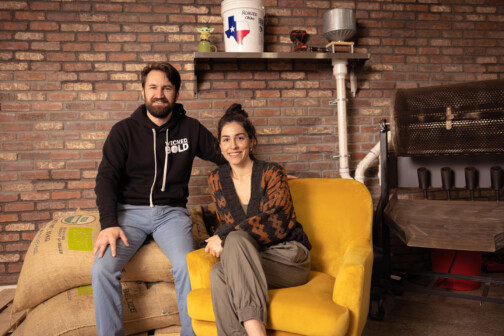Theatre takes collaboration. When it works, many artists’ contributions meld together and the results are greater than could be achieved individually. In the end, it may be almost impossible to untangle the collaborative nexus and trace the individual contributions. Apparently, the same is true for theoretical physics. In Copenhagen in 1921 and in Copenhagen at Stage West, collaboration produced complex and powerful things. The subject of the play is the events at the place. That’s where scientists Bohr and Heisenberg were exploring the frontiers of physics with atomic implications. These were awesome deeds in a no less awesome production. Michael Frayn has written a challenging play full of complex ideas. But if you oppose the current cult of stupidity – you think twitter makes us twits and possess theatrical fortitude – Copenhagen will take you undreamt places and leave you changed. After all, fluid takes the shape of its container, but art changes it.
In 1941, Werner Heisenberg, a German physicist, went to visit Niels Bohr, his former Jewish mentor/colleague, at his home in German occupied Denmark. The subject of this meeting has been subjected to immense scrutiny ever since. Their previous work in theoretical physics would provide the pathway to the atom bomb. In fact, after the meeting, Heisenberg went on to head Germany’s effort and Bohr, after escaping to America, proved invaluable to the work at Los Alamos. What did they talk about? Was it treason? Copenhagen takes the unusual tack of having these two (and Bohr’s wife) try to piece the meeting back together like amnesiacs. It plays out like a thriller, each attempt at recollecting the memory tantalizingly closer to clarity. The playwright maintains the suspense throughout and takes us on a tangled journey that bridges and binds quantum mechanics and human nature. The mystery of one linked to the other in a mind-bending work of historical fact and future consequence.
The actors attack it like the last act of a murder mystery with suppositions, accusations and complete re-enactment reversals with everything you thought for naught. The characters are both inspector and suspect prowling through their own memories. Theoretical physics, philosophy and friendship weave their way in and out, conjuring and coaxing deeper themes from the audience’s experience. The script is excellent, but the actors are even better. This play affords the rare possibility for the task to meet the talent: the area’s best actors taking on characters in a historical context dealing with complex subject matter presented in a conceptual manner. It displays the actors’ intelligence, agility and stamina.
Jerry Russel plays Niels Bohr as a fatherly genius. His most damning comment about someone’s work is to say that it is “interesting.” His Niels is a moral man of dignity and restraint. Chamblee Ferguson plays Heisenberg, the searching and yearning German who cut his teeth under Bohr and has returned to meet with his master. His Heisenberg is a mathematical man, approachable, but proud. In the middle is Magrethe Bohr played by Amber Devlin. Her Magrethe is the mediating mother, protective but caring. She is sometimes the only tether to the human plane for the two scientists and the only one who can help them retrace their accomplishments. Each actor contributes and collects energy and emotion in an exhaustive exploration untangling the contributions these characters shared.
An equally complicated interplay of artistry went into the production design. Jim Covault’s stark set is poetic in its simplicity. The oval-shaped planking and conduit-covered brick backdrop are specific enough in texture and suggestive enough in form to allow director Dana Schultes real playing areas with which to create her stage pictures. This is essential in such a time and space shifting memory play. But more importantly, the silver and white simplicity of the palette provided a canvas-like playground for lighting designer Michael O’Brien. His expressive lighting maintained agile control of the ambience without dictating or distracting. The simplicity of the production design is a unique accomplishment considering the source material and the number of artists involved. It was invaluable help for the audience working to access to the ideas of the script. It takes clarity to combat complexity or as Bohr keeps insisting: plain language. The audience is the last collaborator to join the endeavor and they need all the help they can get. This play takes mountainous effort for all involved. The ascent may not be perfect, but when you summit Everest, who quibbles about the climb? Or in plain language: No pain, no gain.





